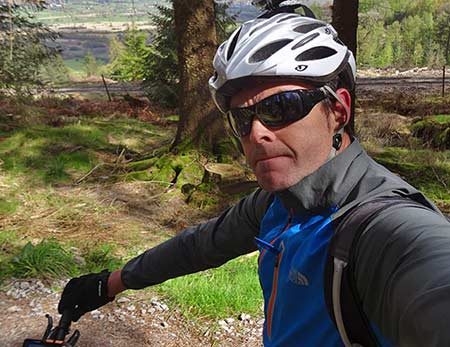
How to choose the right sunglasses for you
Blog home / Gear Matters: Your Guide to Choosing Walking & Cycling Sunglasses

My early days of cycling and mountain walking led me very quickly to realise the value of wearing sunglasses. Cycling fast, I had various run-ins with bees and flies with a combined impact speed probably around 45mph! Then there have been those times on cycling holidays when a series of tiny fly flew into my eyes and started to dissolve leaving me to have to emergency-stop and flush the critter out before I swerved to the wrong side of the road. My early days on walking holidays in the mountains with inadequate sun protection resulted in squinty, tired and gritty feeling eyes. Soon I was investing in decent cycling sunglasses!
One should note at this stage that when we talk of sunglasses, very few brands these days are actually made of glass. Ray Ban, Persol and Vuarnet, for example still make lovely sunglasses from glass, but these may not be always so good for sporting activities; being heavier on the nose bridge than plastics. There is also the slight worry that a glass lens could break or chip in sport and get into the eyes although this is highly unlikely. Most sports sunglasses are a type of plastic such as silicon or Perspex. Generally speaking, these are very strong materials. Oakley were one of the companies that pioneered this manufacture and once boasted ‘bullet proof technology lenses at 10 metres’, their advertisement showing the pock marking on their lenses after a shotgun blast impact, rather than a sniper rifle! Oakley make well-loved sports glasses but may not perform or last as well as models made by manufacturers such as Julbo, Enduro, Tifosi and the likes, for a third of the price. So much for bullet proof protection, my beloved Oakleys eventually fell apart!


Nevertheless, it is probably wise not to buy really cheap shades, slight optical imperfections can in the short-term cause headaches and may do lasting damage in the long-term. Also, importantly the lenses should be shown to block harmful UVA and UVB blue light as this has proven to cause cataracts and retinal problems.
Light Transmission
You don’t have to buy an expensive pair of glasses for cycling or hiking, as long as perhaps they are from a reliable make, have UV protection and are manufactured for the category of light that you are going to expose yourself to. Reasonable specification glasses will normally be marked on the frames or box with ‘Category’ (or CAT) 0 to 4: indicating the Visible Light Transmission (VLT) of the lenses. So, Category 0 is like a safety glass, or a clear cycling glass for grey weather and have a VLT of 80-100% whereas a CAT 3 pair have a VLT of 8-17%, which is fine for most walkers or cyclists. CAT 4 glasses are designed for long periods on snow and ice or in bright conditions such as a beach and have a VLT at 3-8%. CAT 4 sunglasses are provided by manufacturers such as Julbo and Vuarnet – both with side pieces or wrap rounds and the latter still using some optically correct glass lenses.
Especially for cyclists it is worth considering a pair of polarised sunglasses. Ordinary tinted sunglass lenses only cut down on ambient light that reaches the eye, or VLT. However by their very nature, they cannot block glare. Only polarised lenses can block glare and not having that option could be dangerous if you are riding your bike.
Tests show that the most protective sunglasses are wrap rounds that protect the eyes from incidental ambient light entering from the side. The wrap round can either be a continuation of the lens, or plastic frame or more traditionally, leather side pieces. Quite a number of cycling shades now have some cut-outs of lens material between the frames and the lens, although this may slightly increase incidental light. The real advantage of this for cycling is that it ventilates and defogs the glasses when you are cycling or running which is really useful. Examples include the expensive Oakley Jawbreaker and the much cheaper Endura Mullet.
Lens Tints
There is a fashion at the moment for lenses to have a tint that is as reflective as a shaving mirror. However, even on expensive glasses, mirrored tints can easily scratch and even wear off. A lot of manufacturers have their own style of tint, but fundamentally the most common lens colours are brown, then green, then grey. This is because these lenses are 'colour neutral'- they cut down on overall brightness without distorting colours thereby accentuating relief. Quite a few cycling sunglasses have a range of interchangeable lenses with different tints that can be used in different riding conditions. Oakley and Rudy Project do this at the top end and Endura, Maddison, DHB, Tifosi and others do so at the more economical end. Of course it can be a bit fiddly changing lenses, so for some people photo-chromatic lenses maybe a way forward as they darken or lighten depending upon light intensity (for instance: Julbo Aero bike glasses).

Frames
No matter how good the lenses are, it won’t help if the frames let you down - they are after all, the support for the structure. Make sure that when you try the glasses that they fit well and you don’t have to keep sliding them up the bridge of your nose like Agnes does with her glasses in Mrs Brown’s Boys. A lot of the sporting shades do have rubberised ear and nose pieces which make them more secure and stop them from bouncing around when you are doing sports. Frames bend out and fatigue; if you keep them on the top of your head when you are not using them, they will tend to overstretch and then they never fit snuggly anymore. Instead, keep them in a case clipped to your rucksack if walking and if you are not using them while cycling, do what the cycle pros do, and insert them upside down- sliding the arms through the helmet ventilation slots. Watch out also for sunglasses with ‘crystal’ frames (clear transparent plastic) as clear frame can cause light refraction at certain angles around the lens creating dazzle in your eyes.
Hinges
The hinges of sunglasses will normally break under any kind of stress. Metal frames are more durable than plastic ones and some have a spring induction dampener to prevent overstraining.
Cleaning & Caring of Your Sunglasses
Sunglasses need cleaning regularly especially after cycling or walking when they may be covered in sweat-salt, sun cream, sand particles or even the tiny flies I mentioned earlier. Wash them in warm soapy water, then rinse off. Use the manufacturer’s microfibre wipe for gentle wiping off smears and breathe on the lenses and wipe for polishing. Wash the microfibre wipe regularly. Any screws keep tight, but don’t over tighten.
Prescriptions
The more expensive glasses can be made to a prescription order at some expense. Of course, some manufacturers still produce clip-on sun lenses to go onto the frame of your standard glasses.

Some More Thoughts
Many people, such as myself, normally carry two pairs of sunglasses, just in case one pair gets sat on, gets blown off my face or has a lens or frame failure. However, I have decided not to have such an expensive pair for outdoor activities having wiped out a few pairs over the years. I just leave a nice pair of glass-lens & folding Ray Bans in my main bag for après action, chilling and sightseeing use. Sometimes walking around with cycling glasses on, just makes you look too much like a space cadet!
Just to point out that the only sunglasses that lasted me more than 10 years have been a solid pair of Ray Ban Wayfarers, with large metal hinges, and a pair of Rudy Project cycling and running glasses. There are also my beloved heavy duty Vuarnet Alpine glasses that have been with me for 15 years and I just can’t quite get rid of, even though I maybe should..!
For more of John’s Gear Matters blog articles on topics like looking after your feet, waterproof map cases, gaiters and much more, have a look at the complete Gear Matters blog articles overview.
If you have any questions on what gear you should bring on your walking or cycling holiday, please do get in touch with John and the rest of the Walkers' Britain team. We are happy to assist you with specific questions.